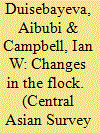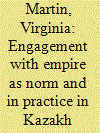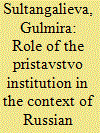|
|
|
Sort Order |
|
|
|
Items / Page
|
|
|
|
|
|
|
| Srl | Item |
| 1 |
ID:
191079


|
|
|
|
|
| Summary/Abstract |
By the end of the nineteenth century, the Russian Empire had significant economic potential. The dynamics of industrial growth influenced both territorial expansion and increased population, and the improvement of the transport system, which also contributed to the formation and development of industry. This process found its expression in the development of textile cloth production, which stimulated the growth of demand for wool and led to the development of commercial sheep-keeping. Sheep-keeping, which played a minor role on both peasant and private farms, became one of the most important economic interests of the empire. The tsarist government’s special interest in using the Kazakh steppes as a source of cheap raw materials for industry led Kazakh animal husbandry to gradually adapt to market requirements. Such changes ignored the fundamental role of traditional sheep-keeping in Kazakh culture and economic life. The loss of habitat and reduction of migration routes for Kazakhs, together with an increase in demand for livestock and livestock products, threatened the degradation of Kazakh sheep-keeping and the loss of a key element of culture.
|
|
|
|
|
|
|
|
|
|
|
|
|
|
|
|
| 2 |
ID:
152306


|
|
|
|
|
| Summary/Abstract |
This article offers an analysis of the Kazakh nomadic political culture of the 1820s–30s with focus on two issues: (1) service and loyalty as elements of Kazakh engagement with the Russian Empire; and (2) the place in local political practice of the regional administrative offices (diwans) created for Middle Horde Kazakh nomads in 1822. While Russia’s goal was ‘bureaucratization’ and creation of ‘order’ in the steppe, in part through directing nomads to engage with the diwan and its elected Kazakh officials, Kazakh political actors variously embraced and rejected formal structures, and continued to define relevant norms and practices of governance. The analysis challenges both statist and nationalist narratives of nineteenth-century Kazakh steppe history by acknowledging the complexities of the Kazakh nomadic experience of empire-building. The ultimate purpose is to suggest new approaches for interpreting historical change throughout the nineteenth century and into the twentieth.
|
|
|
|
|
|
|
|
|
|
|
|
|
|
|
|
| 3 |
ID:
128698


|
|
|
|
|
| Publication |
2014.
|
| Summary/Abstract |
The institution of pristavstvo was introduced in the Kazakh Steppe in the first decade of the nineteenth century. This institution had different meanings and functions, from an individually held position (e.g., a pristav to the kh?n of the Junior Horde in 1820; the pristavs who accompanied the Kazakh delegation to Saint Petersburg in the first half of the nineteenth century) to an administrative-territorial structure (e.g., the pristavstvo of the Senior Horde; the Mangyshlak and Zaisan pristavstvos). Though the political structure of the Russian empire had included institutions analogous to the pristavstvo, it was not a conventional component of the Russian administrative system. Studying the features of the pristavstvo institution in the territory of Kazakhstan and analysing the transformation of the pristav's function provide new insights on how the multi-ethnic Russian empire was managed. They will also help scholars to better understand the forms and methods the Russian authorities employed to manage their nomadic populations.
|
|
|
|
|
|
|
|
|
|
|
|
|
|
|
|
| 4 |
ID:
171132


|
|
|
|
|
| Summary/Abstract |
This article studies an early-twentieth-century reform in local administration on the Kazakh Steppe. It was catalyzed by the massive in-migration of peasant settlers from European Russia, which required fundamentally new administrative forms and institutional decisions from the state. In 1902 the Russian Empire extended the Temporary Regulation on Peasant Nachalniks, which was previously law only in Siberia, to the steppe oblasts of Akmola, Turgai, Semipalatinsk and Uralsk. In examining discussions surrounding the implementation of the new law, this article uncovers the complexity and ambiguities of the decisions that were made, the problems the new law faced, and the wide array of participants in enacting it. The article also compiles a socio-cultural portrait of the peasant nachalniks and the activities they undertook. Finally, it addresses how the Kazakh population perceived these new officials, and how they interacted with representatives of the Kazakh administration, which was crucial to their effectiveness.
|
|
|
|
|
|
|
|
|
|
|
|
|
|
|
|
|
|
|
|
|